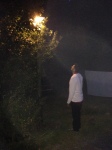 One day a disciple, whose hearing was beginning to fade, asked his master about “sound”. He knew it would be one of the last times he could hear his master’s voice. He wished to take that voice with him on his journey into the realm of silence.
One day a disciple, whose hearing was beginning to fade, asked his master about “sound”. He knew it would be one of the last times he could hear his master’s voice. He wished to take that voice with him on his journey into the realm of silence.
The master replied, “I can see that, given your situation, you are now fully attentive. But why has it taken so long to bring you to a state of such seriousness? Had you listened more closely when your hearing was not impaired, you would not be so anxious now. Is it not so that man was created to listen? What is the use of sound if not to be heard? As you hear the sound of your own voice, remember it is the sound of your Soul.”
The master continued, “There are some sounds that must be silenced and others nurtured. We in our ignorance and ingratitude have equated “presence” solely with sound. The sound of silence into which you are about to enter is not to be understood as a burden but a liberation. It is in such silence that the Divine Command is uttered perhaps. Think of this and rejoice.”
That night as his hearing slipped away he had a dream. He saw a lake of immense proportions, perfectly still. Above him the clouds were racing by at great speed. His heart was beating fast at some strange excitement. By the same swiftness with which they had come the clouds departed leaving him deafened by the sound of his runaway heart! His eyes remained closed.
Before him a single raindrop was descending from the heavens. The sound of its descent was like the song of the peacock, sad and melancholic. He was witnessing the descent of his own Soul! As the drop reached the lake’s surface the sun was rising upon the *horizon. When reaching to half its ascent the sun rose no further. The image falling on the water gave the appearance that it had risen fully, embodied and yet unembodied, reality of the sun and its image upon the water. The drop had now pierced the water. Ripples were forming and being sustained by that same drop which was now like a beating heart until the whole lake was covered by a tide of ripples emanating from one drop. This was what life could be without sound he thought and rejoiced!
By Musa Askari (penned 1992).
* ( … as the eye waits on the rising of the sun, which in its own time appears above the horizon – out of the ocean, as the poets say – and gives itself to our sight” Plotinus)





 O Friend of one who has no friend; O Support of one who has no support; O Peace of one who has no peace; O Companion of one who has no companion; O Proof of one who has no proof; O Refuge of one who has no refuge: Thee alone we worship, and from Thee alone we seek help: Guide us unto the path that is inward and stable.
O Friend of one who has no friend; O Support of one who has no support; O Peace of one who has no peace; O Companion of one who has no companion; O Proof of one who has no proof; O Refuge of one who has no refuge: Thee alone we worship, and from Thee alone we seek help: Guide us unto the path that is inward and stable.

